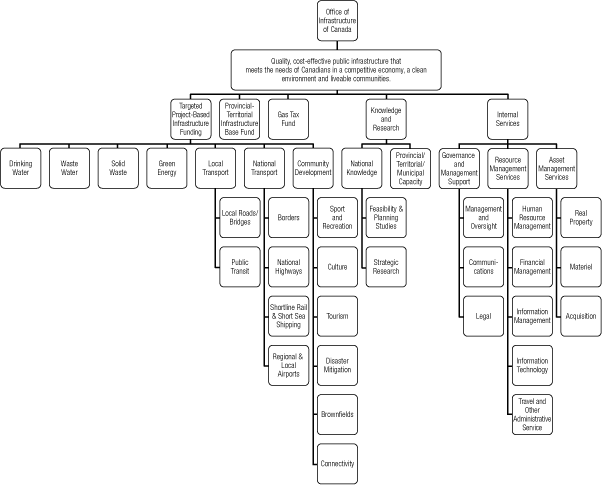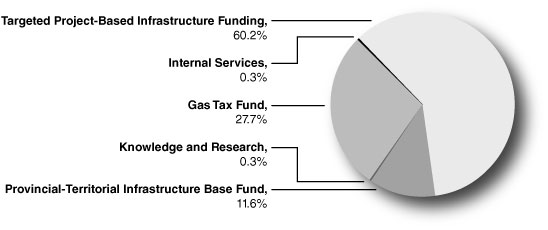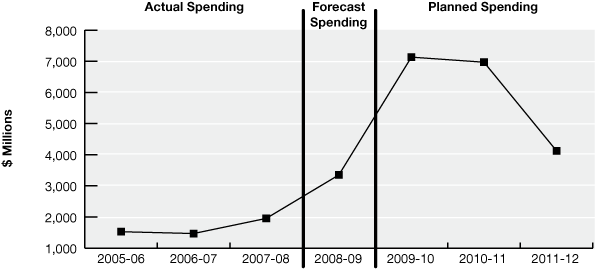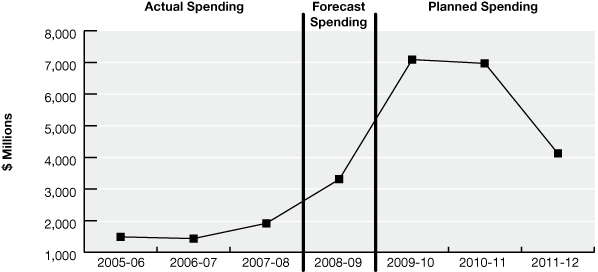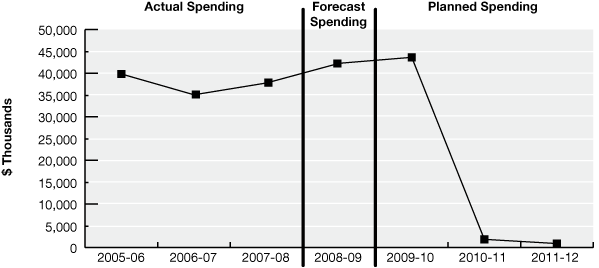Common menu bar links
Breadcrumb Trail
ARCHIVED - Infrastructure Canada
 This page has been archived.
This page has been archived.
Archived Content
Information identified as archived on the Web is for reference, research or recordkeeping purposes. It has not been altered or updated after the date of archiving. Web pages that are archived on the Web are not subject to the Government of Canada Web Standards. As per the Communications Policy of the Government of Canada, you can request alternate formats on the "Contact Us" page.
Minister’s Message

John Baird
As Minister of Transport, Infrastructure and Communities, I am pleased to present Infrastructure Canada’s Report on Plans and Priorities for 2009-10. It describes the department’s commitment to do its part in strengthening Canada’s economy and delivering more modern and greener public infrastructure.
In this time of economic uncertainty, Infrastructure Canada is well placed to help improve Canada’s economy. From major infrastructure projects such as the Evergreen transit line in Vancouver, to helping small communities of less than 100,000 residents undertake projects like upgrading their drinking water systems or building roads and bridges, Infrastructure Canada will play an important role to build a modern Canada. These important investments in infrastructure will help create jobs for Canadians as well as stimulate our economy, improve our quality of life, and contribute to a cleaner environment. This report outlines the initiatives Infrastructure Canada will undertake over the next three fiscal years with a particular emphasis on the next two years of action to stimulate the economy.
The Government of Canada is speeding up funding for much-needed projects through the Building Canada plan and the new funds announced in ‘Canada’s Economic Action Plan’ (Budget 2009); including the Infrastructure Stimulus Fund and the Green Infrastructure Fund. These funds will help provincial, territorial and municipal governments get shovels in the ground and create jobs sooner. We will stimulate the economy, create jobs, cut red tape, reduce duplication and streamline the approval process to speed up the start of necessary infrastructure projects. This will be done while protecting the environment.
Our government understands that a more modern and greener infrastructure is vital to a strong economy, creating jobs and thriving communities – now and over the long term. We remain committed to working with our partners in all levels of government and the private sector, and indeed, all Canadians, to achieve our goals for building a stronger Canada. Infrastructure Canada will get real results for Canadians. We will work to improve Canadians’ prosperity, safety and quality of life. These are our priorities; this is our plan.
I invite you to follow our progress as we implement this plan by visiting our Web site at http://www.buildingcanada-chantierscanada.gc.ca/index-eng.html.
The Honourable John Baird, P.C., M.P.
Minister of Transport, Infrastructure and Communities
Section I: Overview
1.1 Summary Information
1.1.1 Raison d’être
Infrastructure Canada is responsible for federal efforts to enhance Canada’s public infrastructure through strategic investments, key partnerships, sound policies and research. The department exists to ensure that Canadians benefit from world-class public infrastructure.
1.1.2 Responsibilities
Infrastructure Canada was established in 2002 in order to lead the Government of Canada’s efforts in addressing the infrastructure challenges of the country. Since then, the organization has evolved to become a centre of expertise for issues related to infrastructure in cities, communities and regions across Canada.
Several Acts provide legislative authorities for Infrastructure Canada. These include the Canada Strategic Infrastructure Fund Act (2002, c. 9, s. 47) (CSIF), which establishes the Canada Strategic Infrastructure Fund program and contains the authorities for contributions to carry out some strategic infrastructure projects. All other programs are made after the Order in Council 2004-325, which provides authority for the Minister for Infrastructure Canada to enter into transfer payment agreements and contracts related to infrastructure initiatives in Canada. The Canada Strategic Infrastructure Fund specifies the eligible categories within which projects can be funded and eligible recipients, and provides the Minister with the authority to enter into contribution agreements. More recent programs such as the Building Canada Fund have their own criteria regarding eligible project categories and recipients.
Infrastructure Canada is part of the Transport, Infrastructure and Communities (http://www.infc.gc.ca/department/ticp-eng.html) portfolio1. The portfolio addresses several key challenges facing Canada, in particular, those relating to our country’s economic growth, the state of the environment, and the safety and prosperity of our communities. These challenges are priorities for the Government of Canada and will continue to guide the activities of the portfolio.
By managing the $33-billion Building Canada plan and continuing to manage sunsetting funding programs, Infrastructure Canada coordinates several infrastructure initiatives and continues to build the policies, knowledge and partnerships that support them. It also continues to play a strong role in bringing all orders of government, and others, together to work in partnership to support a stronger Canada. The Government of Canada is working with provinces, territories, municipalities, the private sector and various stakeholders to implement the Building Canada plan and the new infrastructure funds announced in Budget 2009 as new infrastructure stimulus funding over two years for short-term infrastructure projects.
1.1.3 Strategic Outcome and Program Activity Architecture
In support of its mandate, Infrastructure Canada has one Strategic Outcome:
Quality, cost-effective public infrastructure that meets the needs of Canadians in a competitive economy, a clean environment and liveable communities.
This strategic outcome reflects the long-term and enduring benefits to Canadians that stem from Infrastructure Canada’s mandate, vision and mission. It focuses on the area of direct influence on investments in quality and cost-effective public infrastructure, and represents a clear end-state for the department to strive towards.
Figure 2 illustrates the Program Activity Architecture of the department, which depicts the structure of Infrastructure Canada’s program activities, sub-activities and sub-sub-activities, whose aim is to clarify how the organization manages the diverse set of programs and activities under its control to move forward the achievement of its strategic outcome.
Figure 2: Program Activity Architecture
1.1.4 Program Activity Architecture Crosswalk
Building on the experience gained in implementing infrastructure programs and given the scope of changes to its responsibilities, Infrastructure Canada sought and received approval from the Treasury Board, in the spring of 2008, to amend its Program Activity Architecture.
Table 1.1 compares the revised Program Activity Architecture with the previous one, in terms of program activities and funding levels. Under the revised Program Activity Architecture, Infrastructure Canada has five program activities:
- Targeted Project-Based Infrastructure Funding: This program activity includes a series of infrastructure contribution programs that reimburse recipients for project-specific costs based on pre-determined eligibility criteria. Project categories vary depending on the specific initiative, but they all contribute to the construction, renewal and/or enhancement of public infrastructure and build infrastructure capacity in partnership with recipients.
- Provincial-Territorial Infrastructure Base Fund: This program activity provides a pre-determined level of base funding to assist provinces and territories with their core infrastructure priorities. An equal annual amount of funding flows in support of each jurisdiction’s annual capital plan once accepted by the Minister, except where provinces and territories have agreed to match accelerated federal funding. Payments are made in advance and provinces and territories may pool, bank, or cash-manage these funds in a manner that will afford them greater flexibility in implementing their annual capital plans.
- Gas Tax Fund: This program activity provides municipalities with predictable and long-term funding, enabling them to invest in infrastructure projects that address local needs and help to produce the shared national outcomes of cleaner air, cleaner water and reduced greenhouse gas emissions. The Gas Tax Fund is administered through agreements between the federal government and provincial/territorial governments that set out eligible infrastructure investment categories, and provide recipients with a pre-determined annual allocation based on a per-capita distribution across jurisdictions. Funds are paid to a province or territory, a municipal association, and the City of Toronto. Provinces, territories or municipal associations in turn provide funding to municipalities.
- Knowledge and Research: This program activity helps to ensure that Canada’s infrastructure investment priorities and activities include the building, connecting and sharing of applied knowledge and research on infrastructure issues, projects and programs. It targets key gaps in infrastructure knowledge and information, promotes the development of an enhanced evidence base for sound decision making among all orders of government, and contributes to improved measurement of the impacts of infrastructure policy and investment decisions. It supports strategic research capacity and knowledge generation and applications at the national level, as well as cooperation with other orders of government in addressing their unique research and capacity-building needs.
- Internal Services: This program activity promotes excellence in program and corporate management in support of Infrastructure Canada’s priorities. Internal services consist of Governance and Management Support (e.g., management and oversight, communications, and legal), Resource Management Services (e.g., human resource management, financial management, information management and technology, and travel and other administrative services) and Asset Management Services (e.g., real property, materiel, and acquisition).
Table 1.1: Program Activity Architecture Crosswalk (in $ thousands)
|
2009-10 |
New Program Activity 1: Targeted Project-Based Infrastructure Funding |
New Program Activity 2: Provincial-Territorial Infrastructure Base Fund |
New Program Activity 3: Gas Tax Fund |
New Program Activity 4: Knowledge and Research |
New Program Activity 5: Internal Services |
Total |
|---|---|---|---|---|---|---|
|
Old Program Activity 1: Infrastructure Investments |
4,293,578 |
823,563 |
1,976,488 |
– |
– |
7,093,629 |
|
Old Program Activity 2: Policy, Knowledge and Partnership Development |
1,800 |
568 |
– |
19,565 |
– |
21,933 |
|
Old Program Activity 3: Internal Services |
1,100 |
– |
– |
– |
18,223 |
19,323 |
|
Total |
4,296,478 |
824,131 |
1,976,488 |
19,565 |
18,223 |
7,134,885 |
|
Reason for Change |
Better reflects that the sub-activities are no longer based on individual funding programs but on seven generic investment categories, three of which have sub- sub-activities. |
New program activity tailored to its unique governance structures and significant resource levels. |
Former sub-activity of Infrastructure Investments is being moved to the Program Activity level. Tailored to its unique governance structures and significant resource levels. |
Recognizes that “Policy” and “Partnerships” were too broad to describe a specific component of a discrete program activity. |
No change. |
1.2 Planning Summary
1.2.1 Financial and Human Resources
Tables 1.2 and 1.3 summarize the financial and human resources for the organization over the planning period.
Table 1.2: Total Financial Resources (Net Cost of Program in $ thousands)
|
2009-10 |
2010-11 |
2011-12 |
|---|---|---|
|
7,134,885 |
6,972,268 |
4,122,670 |
Table 1.3: Total Human Resources (Full-Time Equivalents)
|
2009-10 |
2010-11 |
2011-12 |
|---|---|---|
|
256 |
– |
– |
1.2.2 Program Activities by Strategic Outcome and Planned Spending
Table 1.4 summarizes the expected results of the five main program activities, the planned spending under each activity as well as the alignment of these activities to the Government of Canada outcomes. The overall expected results for these program activities are improved and increased stock of core public infrastructure and improved quality of life and economic opportunities for Canadians. These include cleaner water, safer and faster movement of people and goods on Canada’s major land transportation routes and at its borders, reduced greenhouse gas emissions, cleaner air, stronger and healthier communities, greater understanding of the role and significance of infrastructure and infrastructure issues, and support for environmental sustainable infrastructure.
Table 1.5 provides a more detailed breakdown of planned spending over the next three years.
Table 1.4: Program Activities by Strategic Outcome (in $ thousands)
Strategic Outcome 1: Quality, cost-effective public infrastructure that meets the needs of Canadians in a competitive economy, a clean environment and liveable communities.
|
Program Activity |
Forecast Spending 2008-09 |
Planned Spending |
Alignment to Government of Canada Outcomes |
||
|---|---|---|---|---|---|
|
2009-10 |
2010-11 |
2011-12 |
|||
|
Total Planned Spending |
3,349,745 |
7,134,885 |
6,972,268 |
4,122,670 |
|
|
Targeted Project-Based Infrastructure Funding |
1,649,240 |
4,296,478 |
4,161,494 |
2,138,578 |
Strong Economic Growth1 |
|
Provincial-Territorial Infrastructure Base Fund |
655,054 |
824,131 |
824,196 |
0 |
Strong Economic Growth1 |
|
Gas Tax Fund |
1,013,439 |
1,976,488 |
1,974,452 |
1,974,452 |
Strong Economic Growth1 |
|
Knowledge and Research |
9,135 |
19,565 |
11,167 |
9,167 |
Innovative and Knowledge-based Economy1 |
|
Internal Services |
22,877 |
18,223 |
959 |
473 |
|
1. For description of the Government of Canada Outcomes, please access the Treasury Board Secretariat web site at http://www.tbs-sct.gc.ca/pubs_pol/dcgpubs/mrrsp-psgrr/wgf-cp-eng.asp.
Table 1.5: Departmental Planned Spending (in $ thousands) and Full-time Equivalents
|
Forecast Spending 2008-09 |
Planned Spending 2009-10 |
Planned Spending 2010-11 |
Planned Spending 2011-12 |
|
|---|---|---|---|---|
|
Infrastructure Investments (Old Program Activity Architecture) |
2,439,825 |
– |
– |
– |
|
Policy, Knowledge and Partnership Development (Old Program Activity Architecture) |
15,715 |
– |
– |
– |
|
Targeted Project-Based Infrastructure Funding |
1,817,307 |
1,655,889 |
1,891,820 |
|
|
Provincial-Territorial Infrastructure Base Fund |
329,131 |
329,196 |
329,275 |
|
|
Gas Tax Fund |
1,976,488 |
1,974,452 |
1,974,452 |
|
|
Knowledge and Research |
19,565 |
11,167 |
9,167 |
|
|
Internal Services |
18,223 |
959 |
473 |
|
|
Total Main Estimates |
2,455,537 |
4,160,714 |
3,971,662 |
4,205,187 |
|
Adjustments: |
||||
|
Budget 2009: |
||||
|
Green Infrastructure Fund |
200,000 |
200,000 |
200,000 |
|
|
Communities Component of the Building Canada Fund |
250,000 |
250,000 |
||
|
Accelerating payments under the Provincial-Territorial Base Funding Initiative |
495,000 |
495,000 |
(329,275) |
|
|
Infrastructure Stimulus Fund |
2,000,000 |
2,000,000 |
||
|
Supplementary Estimates: |
||||
|
Building Canada Fund |
390,676 |
– |
– |
– |
|
Canada Strategic Infrastructure Fund |
103,411 |
29,171 |
55,606 |
46,758 |
|
Provincial-Territorial Infrastructure Base Funding Program |
326,715 |
– |
– |
– |
|
Border Infrastructure Fund |
45,082 |
– |
– |
– |
|
Municipal Rural Infrastructure Fund |
– |
– |
– |
– |
|
Gas Tax Fund |
24,644 |
– |
– |
– |
|
Research, Knowledge and Outreach |
2,168 |
– |
– |
– |
|
Other |
||||
|
Collective Bargaining Agreement TB Vote 15 |
120 |
– |
– |
– |
|
Operating Budget Carry Forward TB Vote 22 |
1,368 |
– |
– |
– |
|
Employee Benefit Plan (EBP) |
24 |
– |
– |
– |
|
Total Adjustments |
894,208 |
2,974,171 |
3,000,606 |
(82,517) |
|
Net Planned Spending |
3,349,745 |
7,134,885 |
6,972,268 |
4,122,670 |
|
Plus: Cost of services received without charge |
2,175 |
2,286 |
828 |
763 |
|
Total Departmental Spending |
3,351,920 |
7,137,171 |
6,973,096 |
4,123,434 |
|
Approved Full-time Equivalents |
256 |
256 |
– |
– |
1.3 Risk Analysis
1.3.1 Changing Economic Conditions and Government-wide Priorities
The Canadian economy currently faces extraordinary challenges as a result of global financial volatility. Given current economic circumstances, Infrastructure Canada will implement measures aimed at reducing duplication, streamlining federal processes, fast tracking project approvals and accelerating funding under the Building Canada plan and the new infrastructure funds announced in Budget 2009 in partnership with provincial, territorial and municipal governments. This effort includes the identification of specific projects in each jurisdiction that could be advanced to begin construction in the next two years.
The Government of Canada’s ability to accelerate infrastructure funding is largely dependent on the ability of provinces, territories and municipalities to identify projects that are ready for construction and can be fast-tracked and to match accelerated federal funding where cost-sharing is required. Successfully accelerating infrastructure funding also depends on the success of the proposed regulatory streamlining measures, particularly for federal environmental assessment requirements. Infrastructure Canada will work closely with its partners to overcome approval and implementation barriers on a sustained basis.
1.3.2 Oversight of Infrastructure Projects
Fast tracking project approvals and accelerating funding under the Building Canada plan in partnership with provincial, territorial and municipal governments will place additional pressures on the department’s ability to provide adequate oversight of projects. As part of the update of the Corporate Risk Profile in 2008, oversight of infrastructure projects was assessed as the second highest risk to Infrastructure Canada’s achievement of its mandate. Existing mitigation measures such as the establishment of accountability mechanisms; e.g., contribution agreements, memoranda of understanding, legal agreements, the creation of oversight or management committees and enhancements to reporting systems (e.g., Shared Information Management System for Infrastructure) have all contributed to reducing the likelihood and impact of this risk.
1.3.3 Organizational Effectiveness
In 2008, the re-assessment of key corporate risks identified human resources challenges as the most significant risk to the department’s ability to deliver on its mandate. Although the implemented mitigation measures identified in the 2007 Corporate Risk Profile effectively reduced the likelihood of this risk occurring, the assessment of its potential impact on the department remained high. As such, continued vigilance will be required in mitigating this risk including ongoing implementation of actions outlined in Infrastructure Canada’s Integrated Human Resources Plan, providing early support to new employees by offering orientation sessions and distributing the Departmental Orientation Guide to new employees as well as developing procedures and tools to accomplish their tasks.
1.4 Contribution of Priorities to Strategic Outcome
|
Operational Priority |
Type |
Links to Strategic Outcome |
Description |
|---|---|---|---|
|
1. Expedite investments in provincial, territorial and municipal infrastructure projects. |
New |
SO 1 |
Infrastructure Canada will implement measures aimed at reducing duplication, streamlining federal processes, fast tracking project approvals and accelerating funding under the Building Canada plan and the new infrastructure funds announced in Budget 2009 in partnership with provincial, territorial and municipal governments. |
|
Management Priority |
Type |
Links to Strategic Outcome |
Description |
|---|---|---|---|
|
1. Respond to the opportunities for improvement in the Management Accountability Framework assessment of 2008. |
New |
SO 1 |
Improve the department’s Management Accountability Framework results in support of its Program Activity Architecture. |
|
2. Supporting public service renewal and improving people management. |
Ongoing |
SO 1 |
Continue implementing Infrastructure Canada’s Integrated Human Resources Plan. |
1.5 Expenditure Profile
1.5.1 Allocation of Funding by Program Activity
For the 2009-10 fiscal year, Infrastructure Canada plans to spend $7.1 billion to meet the expected results of its program activities and contribute to its strategic outcome. Figure 3 displays the 2009-10 allocation by program activity.
Figure 3: 2009-10 Allocation by Program Activity
1.5.2 Departmental Spending Trend
The figures 4 to 6 present Infrastructure Canada’s spending trends from 2005-06 to 2011-12.
Figure 4: Spending Trend for Infrastructure Canada
For the 2005-06 to 2007-08 periods, total spending includes all Parliamentary appropriation sources: Main Estimates, Supplementary Estimates, Treasury Board Vote 10, 15 and 22. It also includes carry-forward adjustments. For the 2009-10 to 2011-12 periods, the total spending corresponds to the planned spending including the new infrastructure funds announced in Budget 2009.
Figure 5: Spending Trend for the Contribution Vote
From 2005-06 to 2009-10, the major increases in the Contribution Vote are due to the increase to the Gas Tax Fund and the establishment of two new contribution programs, namely, the Building Canada Fund and the Provincial-Territorial Infrastructure Base Fund as well as the new infrastructure funds announced in Budget 2009.
Figure 6: Spending Trend for the Operating Vote
Infrastructure Canada does not have permanent A-base operating funding. In the past, its operating requirements have been funded from resources earmarked for the administrative costs of major infrastructure programs. For the two largest programs, Gas Tax Fund and other funds under the Building Canada plan, no such provision was made. As such, the drop between 2009-10 and 2010-11, displayed in figure 6, reflects that Infrastructure Canada has not yet been provided with operating funds for 2010-11 and future years.
1.5.3 Voted and Statutory Items
Table 1.7: Voted and Statutory Items Listed in Main Estimates (in $ thousands)
|
Vote # or Statutory Item (S) |
Truncated Vote or Statutory Wording |
2008-09 Main Estimates1 |
2009-10 Main Estimates1 |
|---|---|---|---|
|
|
TOTAL |
2,455,537 |
4,160,714 |
|
50 |
Operating expenditures |
37,530 |
40,283 |
|
55 |
Contributions |
2,414,778 |
4,117,074 |
|
(S) |
Contributions to employee benefit plans |
3,229 |
3,357 |
Main Estimates can be accessed at http://www.tbs-sct.gc.ca/est-pre/20092010/p2-eng.asp.

